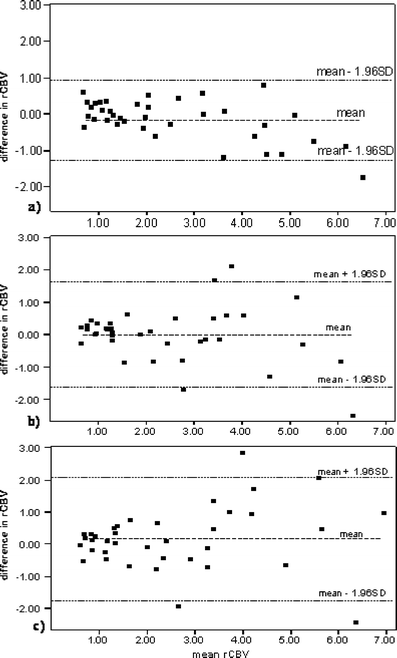Cerebral blood volume, genotype and chemosensitivity in oligodendroglial tumours
- PMID: 16937145
- PMCID: PMC1592467
- DOI: 10.1007/s00234-006-0122-z
Cerebral blood volume, genotype and chemosensitivity in oligodendroglial tumours
Abstract
Introduction: The biological factors responsible for differential chemoresponsiveness in oligodendroglial tumours with or without the -1p/-19q genotype are unknown, but tumour vascularity may contribute. We aimed to determine whether dynamic susceptibility contrast (DSC) magnetic resonance imaging (MRI) could distinguish molecular subtypes of oligodendroglial tumour, and examined the relationship between relative cerebral blood volume (rCBV) and outcome following procarbazine, lomustine and vincristine (PCV) chemotherapy.
Methods: Pretherapy rCBV was calculated and inter- and intraobserver variability assessed. Allelic imbalance in 1p36, 19q13, 17p13, 10p12-15, and 10q22-26 and p53 mutation (exons 5-8) were determined. rCBV was compared with genotype and clinicopathological characteristics (n=37) and outcome following PCV chemotherapy (n=33).
Results: 1p/19q loss was seen in 6/9 grade II oligodendrogliomas, 6/14 grade II oligoastrocytomas, 4/4 grade III oligodendrogliomas, and 3/10 grade III oligoastrocytomas. rCBV measurements had good inter- and intraobserver variability, but did not distinguish histology subtype or grade. Tumours with 1p/19q loss had higher rCBV values (Student's t-test P=0.001). Receiver operating characteristic analysis revealed a cut-off of 1.59 for identifying genotype (sensitivity 92%, specificity 76%). Tumours with high and low rCBV showed response to chemotherapy. The -1p/-19q genotype, but not rCBV, was strongly associated with response, progression-free and overall survival following PCV chemotherapy. Tumours with high rCBV and intact 1p/19q were associated with shorter progression-free and overall patient survival than those with intact 1p/19q and low rCBV or high rCBV and 1p/19q loss.
Conclusion: rCBV identifies oligodendroglial tumours with 1p/19q loss, but does not predict chemosensitivity. The prognostic significance of rCBV may differ in oligodendroglial tumours with or without the -1p/-19q genotype.
Figures





Similar articles
-
Clinical use of genotype to predict chemosensitivity in oligodendroglial tumors.Neurology. 2006 Jun 13;66(11):1661-7. doi: 10.1212/01.wnl.0000218270.12495.9a. Neurology. 2006. PMID: 16769937
-
Histological growth patterns and genotype in oligodendroglial tumours: correlation with MRI features.Brain. 2006 Jul;129(Pt 7):1884-91. doi: 10.1093/brain/awl108. Epub 2006 May 2. Brain. 2006. PMID: 16670176
-
High cerebral blood volume in human gliomas predicts deletion of chromosome 1p: Preliminary results of molecular studies in gliomas with elevated perfusion.J Magn Reson Imaging. 2007 Jun;25(6):1113-9. doi: 10.1002/jmri.20920. J Magn Reson Imaging. 2007. PMID: 17520715
-
Chemotherapy of oligodendroglial tumours: current developments.Forum (Genova). 2000 Apr-Jun;10(2):108-18. Forum (Genova). 2000. PMID: 10875973 Review.
-
[The oligodendroglioma: the value of histologic and genetic diagnosis in predicting sensitivity to chemotherapy].Ned Tijdschr Geneeskd. 2005 Jun 18;149(25):1379-85. Ned Tijdschr Geneeskd. 2005. PMID: 15997690 Review. Dutch.
Cited by
-
Brain perfusion and permeability in patients with advanced, refractory glioblastoma treated with lomustine and the transforming growth factor-β receptor I kinase inhibitor LY2157299 monohydrate.Oncol Lett. 2015 Jun;9(6):2442-2448. doi: 10.3892/ol.2015.3106. Epub 2015 Apr 8. Oncol Lett. 2015. PMID: 26137087 Free PMC article.
-
11C-methionine uptake correlates with combined 1p and 19q loss of heterozygosity in oligodendroglial tumors.AJNR Am J Neuroradiol. 2013 Jan;34(1):85-91. doi: 10.3174/ajnr.A3173. Epub 2012 Jul 5. AJNR Am J Neuroradiol. 2013. PMID: 22766670 Free PMC article.
-
Hemodynamic Imaging in Cerebral Diffuse Glioma-Part B: Molecular Correlates, Treatment Effect Monitoring, Prognosis, and Future Directions.Cancers (Basel). 2022 Mar 5;14(5):1342. doi: 10.3390/cancers14051342. Cancers (Basel). 2022. PMID: 35267650 Free PMC article. Review.
-
Quantitative imaging biomarkers in neuro-oncology.Nat Rev Clin Oncol. 2009 Aug;6(8):445-54. doi: 10.1038/nrclinonc.2009.92. Epub 2009 Jun 23. Nat Rev Clin Oncol. 2009. PMID: 19546864 Review.
-
Noninvasive differentiation of molecular subtypes of adult nonenhancing glioma using MRI perfusion and diffusion parameters.Neurooncol Adv. 2022 Feb 21;4(1):vdac023. doi: 10.1093/noajnl/vdac023. eCollection 2022 Jan-Dec. Neurooncol Adv. 2022. PMID: 35300151 Free PMC article.
References
-
- {'text': '', 'ref_index': 1, 'ids': [{'type': 'DOI', 'value': '10.1200/JCO.2003.06.023', 'is_inner': False, 'url': 'https://doi.org/10.1200/jco.2003.06.023'}, {'type': 'PubMed', 'value': '12525516', 'is_inner': True, 'url': 'https://pubmed.ncbi.nlm.nih.gov/12525516/'}]}
- Buckner JC, Gesme D Jr, O’Fallon JR et al (2003) Phase II trial of procarbazine, lomustine, and vincristine as initial therapy for patients with low-grade oligodendroglioma or oligoastrocytoma: efficacy and associations with chromosomal abnormalities. J Clin Oncol 21:251–255 - PubMed
-
- {'text': '', 'ref_index': 1, 'ids': [{'type': 'DOI', 'value': '10.1093/jnci/90.19.1473', 'is_inner': False, 'url': 'https://doi.org/10.1093/jnci/90.19.1473'}, {'type': 'PubMed', 'value': '9776413', 'is_inner': True, 'url': 'https://pubmed.ncbi.nlm.nih.gov/9776413/'}]}
- Cairncross JG, Ueki K, Zlatescu MC et al (1998) Specific genetic predictors of chemotherapeutic response and survival in patients with anaplastic oligodendrogliomas. J Natl Cancer Inst 90:1473–1479 - PubMed
-
- {'text': '', 'ref_index': 1, 'ids': [{'type': 'PubMed', 'value': '11309331', 'is_inner': True, 'url': 'https://pubmed.ncbi.nlm.nih.gov/11309331/'}]}
- Ino Y, Betensky RA, Zlatescu MC et al (2001) Molecular subtypes of anaplastic oligodendroglioma: implications for patient management at diagnosis. Clin Cancer Res 7:839–845 - PubMed
-
- {'text': '', 'ref_index': 1, 'ids': [{'type': 'PubMed', 'value': '10653879', 'is_inner': True, 'url': 'https://pubmed.ncbi.nlm.nih.gov/10653879/'}]}
- Smith JS, Perry A, Borell TJ, et al (2000) Alterations of chromosome arms 1p and 19q as predictors of survival in oligodendrogliomas, astrocytomas, and mixed oligoastrocytomas. J Clin Oncol 18:636–645 - PubMed
-
- {'text': '', 'ref_index': 1, 'ids': [{'type': 'DOI', 'value': '10.1097/00019052-200412000-00006', 'is_inner': False, 'url': 'https://doi.org/10.1097/00019052-200412000-00006'}, {'type': 'PubMed', 'value': '15542975', 'is_inner': True, 'url': 'https://pubmed.ncbi.nlm.nih.gov/15542975/'}]}
- van den Bent MJ (2004) Advances in the biology and treatment of oligodendrogliomas. Curr Opin Neurol 17:675–680 - PubMed
Publication types
MeSH terms
Substances
LinkOut - more resources
Full Text Sources
Medical
Research Materials
Miscellaneous

